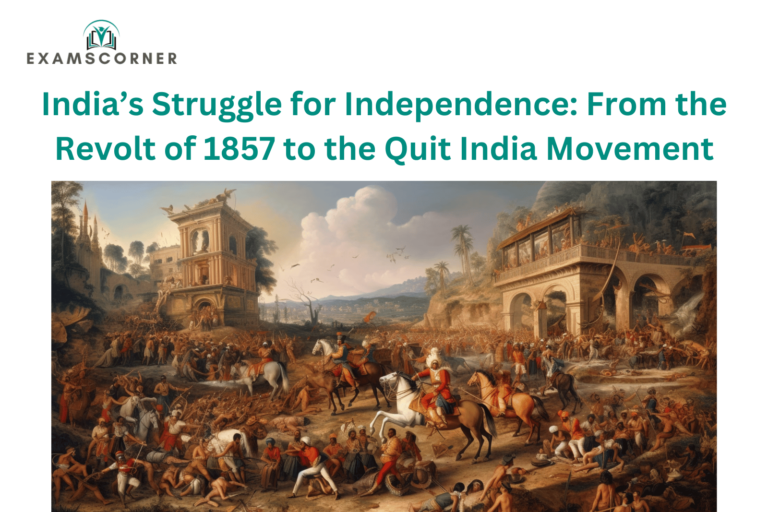India’s struggle for independence is a monumental chapter in the nation’s history. With the arrival of Europeans, especially the East India Company, the seeds of resistance were sown. Official control over India began with the Regulating Act of 1773, setting the stage for colonial exploitation and triggering a long, determined struggle for freedom.
The Revolt of 1857: The First War of Independence
The Revolt of 1857 marked the first large-scale uprising against British rule in India. British policies of expansionism, economic exploitation, and administrative changes adversely impacted Indian rulers, sepoys, zamindars, peasants, traders, artisans, and intellectuals alike.
This widespread discontent erupted into a violent rebellion in 1857, shaking the British Empire’s foundation. Though ultimately unsuccessful, the revolt laid the groundwork for future nationalist movements by uniting various sections of Indian society.
The Swadeshi Movement: Unity Against Partition
The Swadeshi Movement was born out of resistance to the British decision to partition Bengal in 1903. The partition aimed to divide the region into two provinces:
- Western Bengal, including Bihar and Orissa
- Eastern Bengal and Assam
This move was seen as an attempt to weaken nationalist sentiments. The Swadeshi Movement emphasized the boycott of British goods and promoted indigenous industries, sparking a wave of self-reliance and cultural pride across the country.
The Home Rule League Movement
India’s response to World War I was reflected in the Home Rule Movement, initiated by Annie Besant and Bal Gangadhar Tilak. Inspired by the Irish Home Rule Leagues, the movement advocated for greater self-governance within the British Empire.
This movement was instrumental in mobilizing public opinion and laying the foundation for future mass movements against British rule.
Satyagraha: Gandhi’s Early Struggles
Between 1917 and 1918, Mahatma Gandhi led three significant struggles:
- Champaran Satyagraha: Addressing the plight of indigo farmers in Bihar.
- Ahmedabad Satyagraha: Fighting for workers’ rights in textile mills.
- Kheda Satyagraha: Supporting peasants affected by crop failure and tax burdens.
These movements established Gandhi as a key leader in India’s independence struggle and introduced non-violent resistance (Satyagraha) as a powerful tool for change.
Non-Cooperation Movement
Launched formally on August 31, 1920, the Non-Cooperation Movement was a significant phase in India’s freedom struggle. Led by the Khilafat Committee, the movement aimed to boycott:
- British goods
- Educational institutions
- Social events
- Government offices
The objective was to cripple British administration through peaceful resistance, uniting Indians across religious and social lines.
Civil Disobedience Movement: Salt Satyagraha
The Civil Disobedience Movement was a response to the failure of British authorities to meet Indian demands for Purna Swaraj (complete independence).
Key Developments:
- In December 1928, the Nehru Report advocated dominion status for India, but younger leaders like Jawaharlal Nehru, Subhash Chandra Bose, and S. Satyamurthy demanded complete independence.
- In 1930, Gandhi launched the Salt Satyagraha after his demands to Lord Irwin were ignored. This campaign used salt tax as a symbol of colonial oppression, rallying millions of Indians to defy British laws peacefully.
The Quit India Movement
The Quit India Movement was launched during World War II, following the failure of the Cripps Mission in March 1942.
Key Moments:
- On July 14, 1942, the Congress Working Committee met at Wardha and passed a resolution calling for British withdrawal.
- Mahatma Gandhi advocated a non-violent, non-cooperation movement to resist both British rule and a potential Japanese invasion.
This final mass movement marked the crescendo of India’s freedom struggle, uniting millions in their demand for complete independence.
Conclusion
India’s struggle for independence was a journey marked by resilience, unity, and the indomitable spirit of its people. From the Revolt of 1857 to the Quit India Movement, each phase contributed significantly to the ultimate achievement of freedom in 1947.
These historic movements not only challenged British authority but also fostered a sense of national identity that remains a cornerstone of India’s democratic fabric today.



